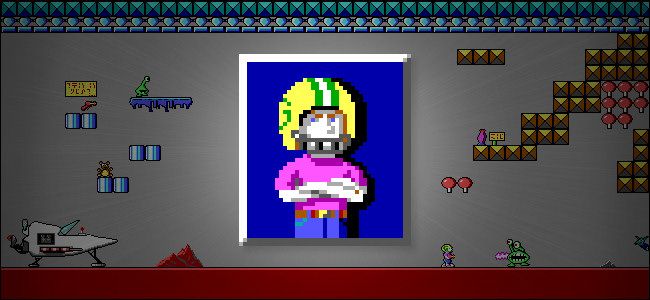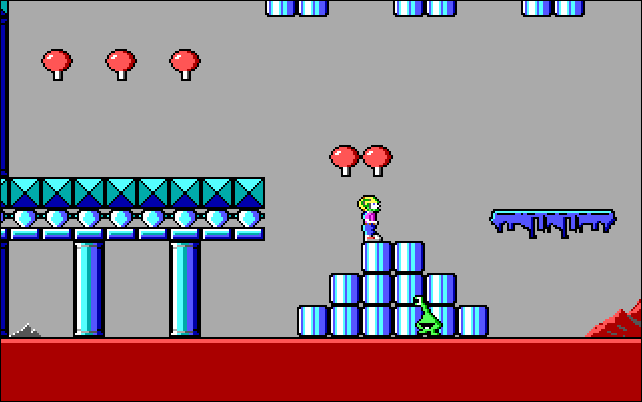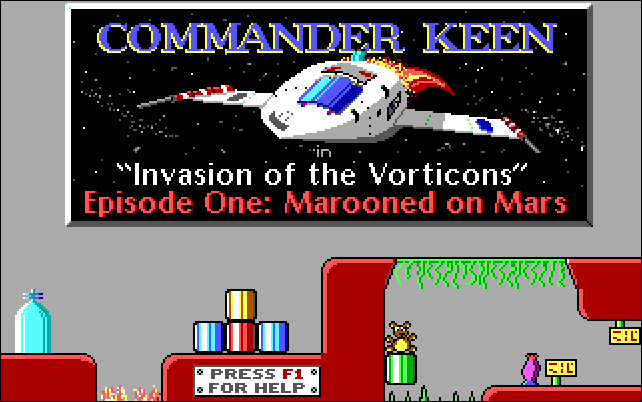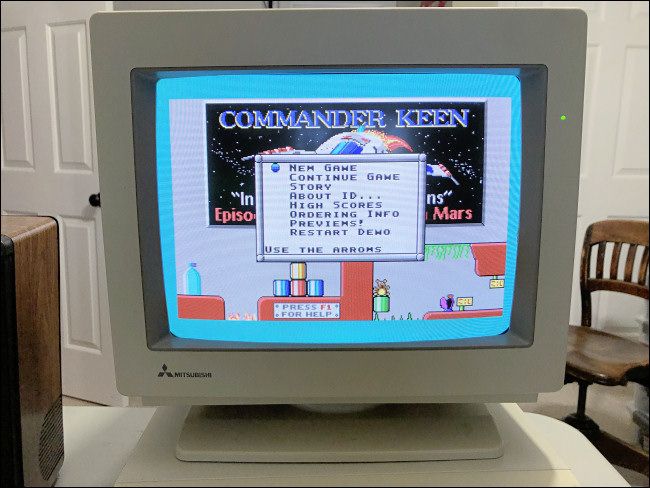Quick Links
On Dec. 14, 1990, Apogee Software released Commander Keen: Invasion of the Vorticons. It was the first in a series of PC shareware games that brought fluid, Mario-like platforming to the PC. It also launched legendary developer id Software. Here's why it was special.
Keen: Playful Console Magic on the PC
The first Commander Keen game, Invasion of the Vorticons, is split into three episodes designed for PCs with MS-DOS. In the first episode, you play as Billy Blaze (aka Commander Keen), a kid who must travel to Mars to repel an invasion of dog-like aliens called Vorticons.
The aliens have dismantled your ship and scattered its parts across the planet. Your job is to retrieve those parts so you can get back home.
Along the way, Commander Keen builds a compelling backstory through special stages. The mini-narrative scenes present items like a pogo stick and an alien language written in glyphs. Keen also picks up whimsical items, like teddy bears and books with the word "KANT" on them. This gives the game a playful feel of a genius boy who loves teddy bears but reads Immanuel Kant.
At the time of its release, Keen's real achievement was the fluid, Mario-style of platforming gameplay on the IBM PC. Few thought this was even possible, given side-scrolling platformer games were the most popular on home video game consoles at the time.
People with PCs, though, could get a taste of console-style gaming by downloading a free game from a BBS, thanks to Commander Keen. This was magical at the time.
To understand why, let's rewind and take a look at what gaming and computing were like the year of Keen's release.
1990: The Year of Mario
In 1990, the Nintendo Entertainment System console was at the pinnacle of its success thanks to smoothly scrolling platform games, like Super Mario Bros. 3. The smooth scrolling of Super Mario Bros. (1985) was the technical breakthrough that made it the stunning, killer-app that it was.
The secret of Super Mario Bros. 3 was that each cartridge included a special memory management chip that assisted the NES's own native scrolling abilities on-screen. Other consoles included special graphics handling and acceleration hardware, as well, which made smooth-action games relatively easy to make.
In the late 1980s, though, almost no IBM PC compatibles included game-oriented graphics acceleration hardware. Instead, programmers worked with standards created by IBM, including CGA, EGA, and VGA, all of which required software tricks to create interesting graphical effects.
Due to these technical limitations, very few PC games at the time had attempted to duplicate the Mario run-and-jump platform. It's also why slower-paced games, like RPG, strategy, and simulation titles, dominated the PC game market back then.
Carmack's EGA Breakthrough
One programmer, in particular, changed the future course of PC game genres. In mid-1990, John Carmack, who was then working at a publisher called Softdisk, invented a new graphical technique for EGA graphics cards called "adaptive tile refresh." It utilized features of the EGA standard in clever ways to produce smooth, sub-pixel scrolling that was on par with the Mario games.
Soon after, Carmack and his Softdisk colleague, Tom Hall, created a scrolling demo that replicated the first level of Super Mario Bros. 3. It was called Dangerous Dave in Copyright Infringement, as it was based on a character created by another Softdisk employee, John Romero.
When Romero came into work the next day, he was blown away. He realized he held the future of the trio's independent success---away from Softdisk---in his hands.
Soon after, the three developers, working under the name "Ideas from the Deep," secretly crafted a Super Mario Bros. 3 demo while still employed at Softdisk. They used EGA graphics and Carmack's new scrolling engine. Eventually, they pitched it to Nintendo through a friend, and while the company was impressed, it passed on the project.
Enter Commander Keen
Around that time, Scott Miller, the president of shareware publisher Apogee Software, contacted Romero to see if he'd like to come work for him. Romero then pitched Miller a game idea developed by Carmack and Hall about a genius kid who saves the galaxy with a spaceship cobbled together from spare household parts. This became Commander Keen.
In the fall of 1990, Carmack, Romero, and Hall quickly whipped up the first Commander Keen game, Invasion of the Vorticons. According to Romero, Carmack handled the engine and gameplay programming and Hall did the game design and graphics.
Romero coded the level editor, did half the level design, and handled other production work. Adrian Carmack (no relation to John) joined later and contributed some graphics before the game shipped.
Apogee's episodic shareware model was compelling at the time. It used the loose network of dial-up bulletin board systems (BBSes) to distribute the first episode of games for free. Players downloaded the game, and, if they liked it, they could mail a check to Apogee to buy more episodes.
The beauty of shareware is it did an end-run around the entrenched PC game publishing industry. The latter required connections to retail stores, and large investments to duplicate disks and print boxes and manuals.
The shareware model also allowed Apogee to experiment with publishing alternative genres (like console-style action platformers) that might've been shunned by the mainstream PC game publishers.
"Making Keen shareware was critical to its success," recalls Romero. "It was easily accessible to everyone and was legal to pass around. People could just give a copy to their friends to show them something really fun, and it was okay to do that."
Apogee published Commander Keen: Invasion of the Vorticons on Dec. 14, 1990, by making the first episode, "Marooned on Mars," available on BBSes. To get the other two episodes, customers paid $15 each or $30 for the entire trilogy
Miller said the response was overwhelming. Typical Apogee shareware games sold only a few thousand copies, but Commander Keen sold 30,000 in just a few months, and almost 60,000 over the next few years.
Keen's Legacy
The amazing success of Commander Keen charted a new future for both Carmacks, Romero, and Hall.
"The game's first month did so well that all four of us could quit Softdisk and start id Software officially on Feb. 1, 1991," said Romero. "And sales of Keen just kept going higher. By the end of 1991, Keen's sales were five [times that of] the first month's."
id Software would go on to create other technically groundbreaking games, like Wolfenstein 3D, Doom, and Quake. But before that, the quartet worked on several other Commander Keen shareware games, each of which was a success in its own right.
Over the years, there have been several attempts to relaunch the Commander Keen series, including a 2001 Game Boy Color version and a poorly received 2019 mobile reboot that was eventually canceled. Neither captured the magic of the original or the place it held in the zeitgeist.
How to Play Commander Keen on a Modern PC
If you want to play classic Commander Keen today, Invasion of the Vorticons runs under emulation in a pack available on Steam for $4.99. This also includes the sequel, Commander Keen in Goodbye Galaxy! It's the officially supported way to play classic Commander Keen on Windows 10 (or any other recent version). Also, Commander Genius can play the game well on a Mac.
If you happen to have an old MS-DOS PC in a closet, you can drag that out and play Commander Keen as it was originally intended. It still scrolls just as smoothly as it did in 1990.
Happy Birthday, Commander Keen!




